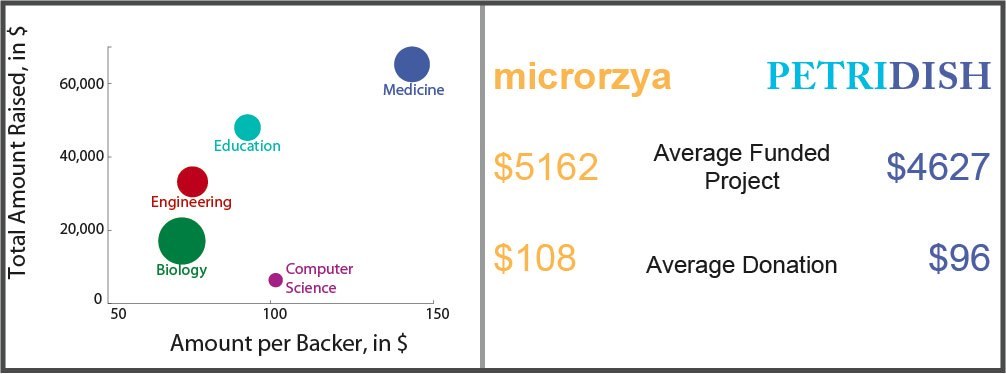|
Operations v. Capital
Atray and I have both struggled with the idea of deliverables. Crowdfunding platforms generally offer prize tiers. Donate $5 and receive a digital pdf. Another $25 and the creators will throw in a hard copy of the product. Kickstarter is an all-or-nothing funding model; the clock ticks down and unless the project meets or exceeds its funding goal, the creators don’t receive a cent. Indiegogo also lets creators set prize tiers, but In contrast, Indiegogo lets creators keep however much money they raise.
Based on these templates, Atray and I mused whether science could be retrofitted to this model. In reality, few science experiments pass the rigor of peer validation. If the business of science means that there are few home runs, then how can scientists promise deliverables as donor incentives?
Bearing this in mind, I scanned one of the newest science crowdfunding sites, Microryza (many of its predecessors are extinct). Creators want to attend a valuable science conference, but their department doesn’t have enough funds (not an unusual story, at least in the humanities. Also not unusual in light of federal funding cuts to science). Others just need to fund a piece of equipment to be used time and again.
In my nonprofit days, we called these operational expenses. These were structural funds that impacted the level of efficacy. If we applied for grants to launch new programs—much of which would be one-time costs to get established, we referred to these as capital asks. Capital projects are sexy. Possibilities! Innovation! But following close behind are projected deliverables. In the traditional granting system, unless the project makes good on those deliverables, it won’t even be considered for additional funding.
Of all the science funding platforms, it seems that Microryza and its users got it right. The only incentive is a pdf report, which whittles down the sort of donor. The asks are for supplies or to fund a leg of a bigger research project.
Public outreach
I didn’t grow up in the ‘60s, but I know it was an exciting time for science. For good or bad, the Cold War ensured our focus on chemistry and physics, and that translated into things like the moon landing. People remember where they were when Neil Armstrong and Buzz Aldrin touched down, and conspiracy theories have survived the test of time.
What does a community builder read from this? Amazing public outreach, that’s what! Since the mid-20th century, ideologies have changed. Regardless of our thoughts on Putin’s selfies and persecution of gays, we’re no longer at war with the USSR. But the politics of that time shouldn’t obscure the power of ideology to fuel science.
The potential of science crowdfunding is public outreach. In the absence of national science promotion or media that resonate with the general public (I once surveyed several science-related magazines, and the majority cater to a $70k+ per annum, male audience), science crowdfunding has an opportunity.
Atray questions multi-million dollar science experiments that ask the public for a few extra thousand dollars to close out. I say that as long as the intent isn’t to round out funding but to engage the public in the experiment, then that’s okay.
The real snag will be in fulfillment.
Atray is just about to start his second year. He spends hours at the lab—at multiple labs. Imagine conducting research, visualizing data and fulfilling public donor incentives—whether that’s a pdf summary or mailing prizes—when you barely have time to prepare a cup-of-noodle.
With an intermediary to manage fulfillment (take a look at Breadpig, which has been handling Ryan North’s Kickstarter), science crowdfunding could be truly effective. There’s plenty of hullabaloo about math and science education crisis, and how to promote STEM research; that energy could be better spent. If there isn’t enough government funding to push for a mass scale science campaign, imagine if each lab had its own outreach coordinator, and how this simple (and relatively inexpensive) role could transform people’s relationship with science.
|
Three Challenges to Crowdfunding Science:
- You can’t raise enough $$ to do REAL science
The short response to this one is simple: you can. Well, at least in one case. On June 27, ARKYD, a Kickstarter-based crowdfunded space telescope reached the astronomical goal of $1 million. Space startup Planetary Resources pushed the venture forward, along with thousands of backers motivated by once-in-a-lifetime rewards like a “selfy” picture from space.
Wait a sec…what is real science and how much money do I need to do it?
It’s hard to imagine a university laboratory with million-dollar research grants in need of an extra couple thousand dollars to complete their cutting-edge experiments. It’s also hard to see scientists publicizing their next big idea before they have secured some amount of credit for it.
If you stretch your definition of “real” science beyond a lab coat in a university lab, I would say that it is possible but perhaps not yet practical for most to crowdfund your science.
- Crowd security – Safety in numbers?
Some relish and others fear the thought of becoming a salesperson of “sexy” science. The concept of the objective scientist exists; that persona would be destroyed by having to exaggerate results and promise rewards.
None of the crowdfunding sites I visited (Petridish, Microryza or even Kickstarter) had any system to ensure the proposed research project was feasible, the anticipated results would be delivered, or would even be valuable if delivered. This puts the burden on individual donors to either reach a level of expertise in a technical field that may be becoming increasingly specialized, or implicitly trust the researcher’s statements prima facie. While in its current form, it seems to be a great way to get people excited and invested in your research or to test the waters with a moderately scaled new idea.
Without some guidance on feasibility and usefulness, I fear it could lead to misguided funding (see recent Science Magazine article on how crowd mentality can bias online preferences).
- It will only catch on in certain disciplines
Opting for a “scientific” approach to this one, I mined the microrzya website at 1800 EST on Aug. 7, 2013. I looked at the distribution of projects and how much funding each one had received by category.

Click for bigger version
Medicine-related projects accrued the largest amounts while there were fewer computer science projects, but each was fairly well funded. Psychology and economics did not have a funded project in existence, but of psychology’s seven projects, four were just launched.
I took a quick peek at petridish.org as well. Interestingly, 28 of their 31 projects were related to animal behavior or conservation (the other three were astronomy, archeology, and climate change-related).
So from the brief overview, it seems to be catching on in multiple disciplines, but the dominant fields, at least for these two sites, were medicine and biology. What I have presented here is a snapshot of a single moment in time, I think it would be interesting to track how the distribution of disciplines seeking and receiving funding through crowdsourcing changes over time. Considering that most disciplines on microzyra that had posted projects received funding, I anticipate the scientific market to grow and diversify.
|



